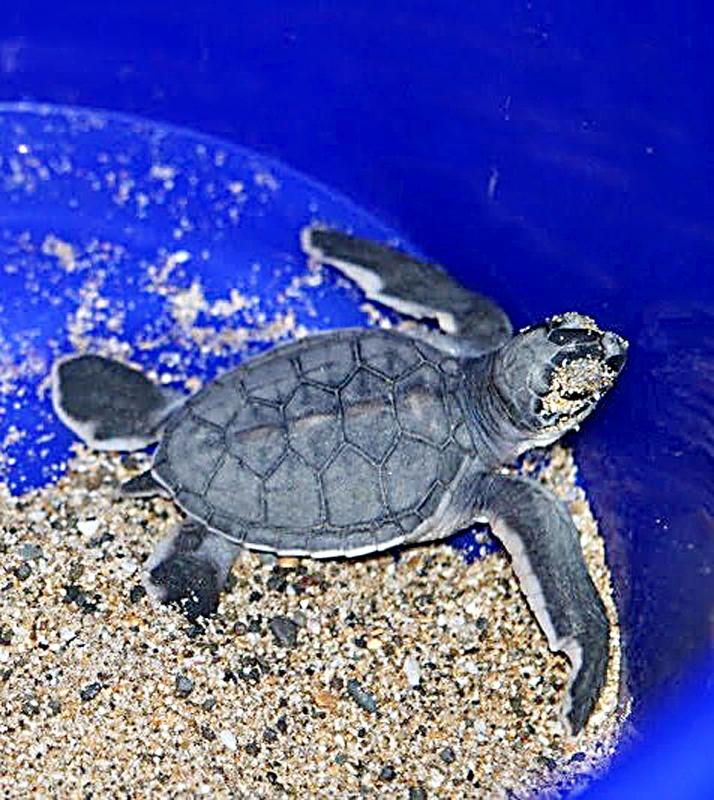At least 56 sea turtle nests have been found on Orchid Island (Lanyu, 蘭嶼) off the coast of Taitung County, and on Siaoliouciou Island (小琉球) off the coast of Pingtung County, exceeding the numbers in the past few years, Ocean Conservation Administration (OCA) officials said on Saturday.
The sea turtle nesting season in Taiwan lasts from May to October, and the reptiles have been found nesting along the coastlines of northern, eastern and southern Taiwan, as well as on the nation’s outlying islands.
However, due to the destruction of habitat, poaching and other threats, only green sea turtles have in the past few years continued to come ashore to lay eggs, mainly at five locations on the outlying islands.

Photo copied by Hung Ting-hung, Taipei Times
Nesting and hatching conditions are still being monitored and data would be publicized after the end of the nesting season, OCA officials said.
The five turtle species commonly seen off Taiwan’s coastlines are the green sea turtle, loggerhead sea turtle, olive ridley sea turtle, hawksbill sea turtle and leatherback sea turtle, the officials said.
Green, loggerhead and olive ridley sea turtles have been recorded nesting on Taiwan proper and the outlying islands, they added.
The five remaining nesting areas for green sea turtles are Wangan Township (望安) in Penghu County, Orchid Island, Siaoliouciou Island, the Pratas Islands (Dongsha Islands, 東沙群島) and Itu Aba Island (Taiping Island, 太平島) in the Spratly Islands (Nansha Islands, 南沙群島), the OCA said.
In 2016, a hawksbill sea turtle laid eggs on a beach at Beiliao Village (北寮) in Penghu County’s Husi Township (湖西), but the eggs were unfertilized and did not hatch.
In 2017, a nest of 27 newly hatched green sea turtles was discovered in Pingtung County’s Kenting (墾丁).
Last year, the first documented nesting of a green sea turtle at Fushan Fish Reserve (富山護魚區) occurred in Taitung County’s Beinan Township (卑南), where 36 sea turtles hatched.
This year, as of the end of last month, the OCA had received reports of people witnessing the nesting or hatching of sea turtles on the beaches of Badai Bay (八代灣) and Siaobadai Bay (小八代灣) on Orchid Island; Yucheng Wei (漁埕尾), Jhong Au (中澳), Duozaiping (肚仔坪), Lobster Cave (龍蝦洞) and Beauty Cave (美人洞) on Siaoliouciou Island and Kenting’s Dawan area (大灣).
Reports also came in from Tiantaishan (天台山), Changlaizi (長瀨仔) and Houdaizi (後袋子) in Penghu County.
Preliminary statistics show 47 reports of nests on Orchid Island, nine on Siaoliouciou Island, seven in Penghu County and at least one in Kenting, the OCA said.
It urged local residents and tourists to avoid beaches where sea turtles nest from 8pm to 5am the next day, and to refrain from using artificial light sources near the beaches, which disturb nesting sea turtles.
The OCA also urged people not to dig holes, build sandcastles, or leave recreational equipment or trash on the beaches, amid concerns that those might become obstacles for the sea turtles.
The agency encouraged the public to call the toll-free coast guard hotline (118) if they find an injured or lost sea turtle.

‘WIN-WIN’: The Philippines, and central and eastern European countries are important potential drone cooperation partners, Minister of Foreign Affairs Lin Chia-lung said Minister of Foreign Affairs Lin Chia-lung (林佳龍) in an interview published yesterday confirmed that there are joint ventures between Taiwan and Poland in the drone industry. Lin made the remark in an exclusive interview with the Chinese-language Liberty Times (the Taipei Times’ sister paper). The government-backed Taiwan Excellence Drone International Business Opportunities Alliance and the Polish Chamber of Unmanned Systems on Wednesday last week signed a memorandum of understanding in Poland to develop a “non-China” supply chain for drones and work together on key technologies. Asked if Taiwan prioritized Poland among central and eastern European countries in drone collaboration, Lin

The Chien Feng IV (勁蜂, Mighty Hornet) loitering munition is on track to enter flight tests next month in connection with potential adoption by Taiwanese and US armed forces, a government source said yesterday. The kamikaze drone, which boasts a range of 1,000km, debuted at the Taipei Aerospace and Defense Technology Exhibition in September, the official said on condition of anonymity. The Chungshan Institute of Science and Technology and US-based Kratos Defense jointly developed the platform by leveraging the engine and airframe of the latter’s MQM-178 Firejet target drone, they said. The uncrewed aerial vehicle is designed to utilize an artificial intelligence computer

Renewed border fighting between Thailand and Cambodia showed no signs of abating yesterday, leaving hundreds of thousands of displaced people in both countries living in strained conditions as more flooded into temporary shelters. Reporters on the Thai side of the border heard sounds of outgoing, indirect fire yesterday. About 400,000 people have been evacuated from affected areas in Thailand and about 700 schools closed while fighting was ongoing in four border provinces, said Thai Rear Admiral Surasant Kongsiri, a spokesman for the military. Cambodia evacuated more than 127,000 villagers and closed hundreds of schools, the Thai Ministry of Defense said. Thailand’s military announced that

CABINET APPROVAL: People seeking assisted reproduction must be assessed to determine whether they would be adequate parents, the planned changes say Proposed amendments to the Assisted Reproduction Act (人工生殖法) advanced yesterday by the Executive Yuan would grant married lesbian couples and single women access to legal assisted reproductive services. The proposed revisions are “based on the fundamental principle of respecting women’s reproductive autonomy,” Cabinet spokesperson Michelle Lee (李慧芝) quoted Vice Premier Cheng Li-chiun (鄭麗君), who presided over a Cabinet meeting earlier yesterday, as saying at the briefing. The draft amendment would be submitted to the legislature for review. The Ministry of Health and Welfare, which proposed the amendments, said that experts on children’s rights, gender equality, law and medicine attended cross-disciplinary meetings, adding that